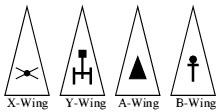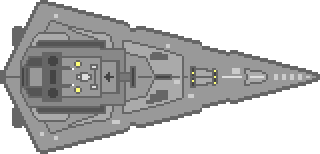Star Wars
The release of Star Wars was a milestone in science fiction film history. It merged high quality space opera adventure with dazzling special effects and brought them to the big screen for the first time. But then, you probably already know that. So, to give you a reason to dig out those old Star Wars models, toys and anything else which brings back nostalgic memories (such as turning your book shelves into the Death Star, and making screeching noises as X-Wings and TIE fighters fight next to it), here's a few rules on converting ships from Star Wars to Full Thrust.
Conversion Notes
Ships in Star Wars are big. The Imperial Class Star Destroyer, the mainstay of the Imperial Fleet, is 1.6km long. It has a volume of over 65 million cubic metres (that's equivalent to over 4.5 million Traveller tonnes). They are not so much a warship, more a small, heavily armed, city. Even the relatively small Nebulon B Frigate is 300 metres in length. Restricting the designs to 100 mass totally looses (IMO) the whole point of Star Wars.
As such, what I've done is to sit down and convert the designs in the Imperial Sourcebook (from the Star Wars Roleplaying Game) directly, and to Hel with the standard Full Thrust mass limitations. As such, the designs given here are big. Really big. But not as big as they could have been.
What I'm basically trying to say is, don't expect to field a whole fleet of Star Destroyers against a fleet of MC80s, and expect to play out the Battle of Endor in an evening. These designs are here for interest value only. Don't expect them to be of practical use.
Turbolasers
Turbolasers are the standard heavy weapon of the Star Wars universe, and are present on most capital ships (the term 'capital ship' is used to designate any large warship, from frigates up to Star Destroyers). Turbolasers are very similar to beam batteries, and use the same symbols, mass and point costs as for beam batteries. They are available in C, B, A and AA varieties. A turbolaser though can only have one arc of fire, but has a range category of 16“.
The AA turbolaser does 4d damage within 16”, 3d out to 32“, 2d out to 48” and 1d out to its maximum range of 64“. The Imperial AA turbolaser has no chance of a misfire. A C turbolaser may fire at fighters within 6”, destroying one on a roll of 6. Any turbolaser may be mounted to fire through the rear arc.
PDAFs also exist, and are used as normal, except that they may be used against ships within 6“. All such targets are treated as having 2 extra levels of shields though - targets with effectively 4 or more levels of shields cannot be damage by PDAFs. It requires use of a FireCon to use PDAFs against non-fighter targets. PDAFs have a 360 degree arc of fire.
I've converted turbolasers into standard Full Thrust beam batteries, according to the damage of the SW lasers. Turbolasers of around 3D damage are C batteries, 5D damage becomes B batteries, 7D are A batteries and 10D are AA mega batteries. The technology of the Empire is such that AA batteries are reliable, having no chance to malfunction.
Ion Cannons
I've translated ion cannons into needle beams, since they both have more or less the same effect, though ion cannons have a range of 16”. They may only fire through a single arc, and have a mass and point cost as per a needle beam. They may be mounted aft.
Tractor Beams
Tractor beams aren't covered by Full Thrust, which is somewhat unusual since they are so common in science fiction. I've assumed mass 5 for a tractor beam, and left the exact rules to another time. I know there are rules for the things floating around on the web, but I haven't had time to go find them.
Imperial Fighters
There are various types of fighters in the Star Wars universe, which can be translated to Full Thrust without too much bother. The fighter types I use are as follows, together with their More Thrust sub types.
| TIE/In | Standard fighter. |
| TIE Bomber | Heavy torpedo fighter |
| TIE Interceptor | Interceptor |
| TIE/fc | Special |
| TIE/rc | Fast/Long range |
| TIE/gt | Attack |
TIE/fc
The TIE/fc is designed for target acquisition duties against larger vessels. It is not particularly good at either dog fighting or attacking larger vessels itself - halve (rounding down) all damage down by a TIE/fc squadron against any target. If the TIE/fc group is within 6“ of a large ship though (ie non-fighters), it can designate targets for any other ship in the Imperial fleet. Each fighter rolls 1d6, and on a roll of 5+, a shot from a single weapon may ignore all shields and armour on the target vessel. The TIE/fc cannot attack, or be involved in a dogfight, while designating targets.
TIE Bomber
The TIE bomber is treated as a standard heavy torpedo fighter, except that it may also attack ground targets from orbit. The 'torpedo' may be launched at planet side targets within 3” as for a single ortillery attack, instead of firing at a ship.
Alliance Fighters
| A-Wing | Fast. |
| B-Wing | Heavy attack. |
| X-Wing | Interceptor, but no penalty against large ships. |
| Y-Wing | Heavy |
Hyperspace
Hyperspace is very safe and reliable in Star Wars, so no problems are caused by jumping into hyperspace when close to other ships. A planet's gravity well still prohibits hyperspace travel though.
Optionally, entry to, and exit from, hyperspace can be done differently to better simulate the 'special effects' used in the films. On the turn after hyperdrives are engaged, during the movement phase, the velocity of the ship is quadrupled. Each turn thereafter, the velocity is quadrupled again until either the ship leaves the board, or a velocity greater than 256“/turn is achieved. At this point, the ship is assumed to have entered hyperspace.
Likewise, a ship exits hyperspace at a velocity greater than 64” a turn (at the start of its movement phase, so it moves 64“ that turn). It's velocity is quartered every turn until it reaches the velocity the ship had when it entered hyperspace. For ships coming in off the board, this is basically anything the controlling player decides before play.
A ship may be assumed to come out of hyperspace off the board, decelerating and only coming onto the board when a low velocity has been reached. The enemy fleet will be aware of any ships coming out of hyperspace this way though, and will now its speed and rough location.
Ships cannot change facing while engaging hyperdrives. A ship may use hyperdrives to move rapidly across the battle area, engaging them for a single turn only. A ship cannot make a second jump within three turns of coming out of the previous, and weapon systems may not be fired, or fighters launched or recovered, while accelerating into, or decelerating out of, hyperspace. Fighters equipped with hyperdrives only have enough energy for two jumps.
Ship Designs
The Empire
Imperial Class Star Destroyer (Mass 4,000; Points ~50,000)
This is a really silly ship design, basically because it is just so damn big. The Star Destroyer though is designed to be a fleet in itself, with massive amounts of firepower, and large numbers of fighters.
A less well known role for the ISD is in planetary assault - a single star destroyer is capable of reducing entire civilisations to slag. For this reason, I've given it large numbers of ortillery systems, as well as drop ships. Also included in the design are minesweeper systems, since these will also be useful when attacking well defended planets.
If you add up the mass of all the systems, you'll find that they don't fill the total available mass of the ship. What isn't noted on the designs are the 9,700 troops, the workshops,the factories, the training rooms, entertainment complexes, the six years of supplies, the 40,000 crew etc etc. These things are cities in space. They can't afford to devote their entire mass to military systems.
Imperial Class Star Destroyer II (Mass 4,000; Points ~50,000)
The Imperial II is an upgraded version of the older Imperial I. It has significantly improved firepower for ship to ship combat, at the expense of ground assault systems. The SW:RPG rules merely list the Imperial II as being better, but since both ships are the same size, upgrading B batteries to A and AA in Full Thrust means something has to go.
Victory Class Star Destroyer (Mass 1,600; Points ~10,000)
The Victory class of star destroyers are much older designs than the Imperial class, dating back to the time of the Clone Wars. They are considerably smaller (900m in length), though they still can be a force to be reckoned with. They were originally designed as planetary assault and defence platforms, and are ill-suited to space combat. They do have the ability to enter the upper atmosphere, and deliver an awesome barrage of highly accurate destructive energy at any planetary target. Their original design assumed they would carry space-to-ground missiles, but they are capable of carrying any of the standard missile configurations.
Victory Class Star Destroyer II (Mass 1,600; Points ~ 10,000)
Right at the end of the Clone Wars, the Victory Class Star Destroyer was redesigned into the Victory II. It is more suited to space combat than its predecessor, having more powerful drive systems, and longer ranged weapon systems. In its conversion, it lost its formidable array of missile systems, but the Emperor wanted the Victory II to be able to serve as a long range patrol vessel. Given such a mission profile, where it would be unable to resupply its missile tubes for a considerable time, they were dropped in favour of reusable systems.




